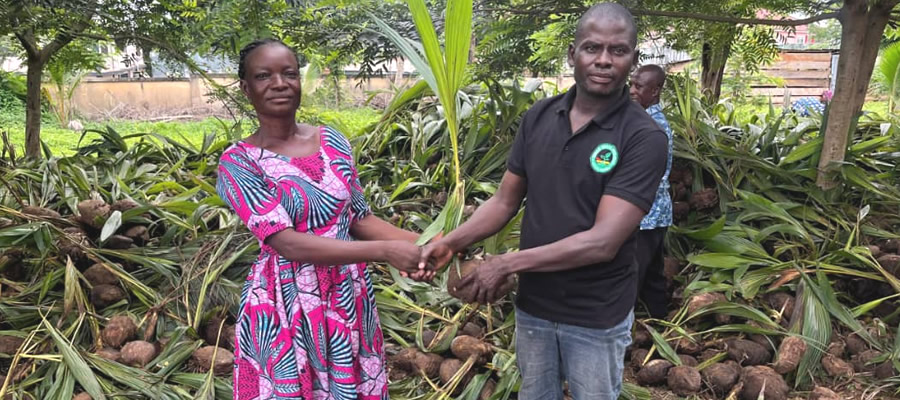

Introduction
One of the most important indicators in assessing the changes in population is its demographic characteristics. The changes in a country’s population are mainly through fertility, mortality and migration levels, which to a large extent, are influenced by age-sex composition. Population size, distribution, age and sex structure is vital for development planning, programme implementation and evaluation. The age and sex composition is of great importance in analyzing the mortality, migration and fertility of the population. This chapter presents information on the distribution of the district's population by age and sex structure, fertility, mortality and migration.
Population Size and Distribution
The Asunafo South District has a total population of 95,580 comprising 48,836 (51.1%) males and 46,744 (48.9%) females with a sex ratio of 104.5. The district is predominantly rural with about three-quarters (70,979) of its population residing in rural settlements. The District has a relatively young population with about 30 percent of the population below 10 years. The aged, that is those 65 years and older, constitute only four percent of the population. A similar pattern is observed among the male and female and then urban and rural populations. The male dominance could be due to rural nature of the district which is suitable for agriculture especially cocoa farming.
Age and sex structure, sex and dependency ratios
The age and sex structure of the population of the District follow the region and the national pattern. The age structure is that of a broad base and reduces gradually in the subsequent age groups and narrows in the older ages.
Age specific sex ratios
The Asunafo South District is one of few districts in the country that are male dominated. With a sex ratio ranging from 78 males for every 100 females in the older ages of 85 and above, to a ratio of 132 males per 100 females in the age group 55 to 99. Males dominate the population below 20 years with a ratio ranging from 103 to 115 males to every 100 females. With a sex ratio ranging from between 86 and 97 males per 100 females, the female dominance in the district population is observed among the young adults aged 20 to 34 years. Subsequently, the sex ratio increases with increasing age and peaks at amongst the population aged 55 to 59 years. The male dominance could be attributed to the fact agriculture is the main stay of the population, especially cocoa farming.
Dependency ratio
The age-dependency ratio is a theoretical concept which does not apply strictly in real population and differs from economic dependency ratio. For example although ages 15-64 are not "dependent" a large proportion of youth 15-19 are "dependent" in practice, that is being at school or not supporting anyone. Similarly, not all persons aged 65 years and over are dependent. The age-dependency ratio is often used as an indicator of the economic burden that the productive portion of a population must bear. Countries with very high birth rates coupled with low death rates usually have the highest age-dependency ratios because of the large proportion of children in the population.
There is not much difference in the dependency ratio between the urban and rural localities. The total age dependency ratio for the district is 87.6, which means that every 100 persons in the working age group have 88 persons in the dependent ages to support. Although the ratio is slightly higher in the rural areas (91.1) than it is in the urban areas (78.1) of the district, the economic burden on the working age population is significant.
Population Pyramid
The age and sex structure of the district is shown in the population pyramid. The pyramid has a relatively large base and tapers off towards the older ages. The Figure provides insightful lessons regarding current and future fertility and migration patterns to enhance policy formulation and infrastructure planning. The pyramid generally shows the expected pattern of declines in the length of the bars for each group with advancing age, except for the population between 10 and 24 years.
The broadness of the base is determined by the level of fertility, while the shape is determined by mortality and to some extent migration. In general, the population pyramid reflects a broad-base pattern, characteristic of a developing nation, with a built-in momentum for the growth when the young population eventually reaches reproductive age. However, if the socio-economic potentials of the youth are properly harnessed and directed, they could contribute significantly to development of the district and the nation as a whole.
Fertility, Mortality and Migration
Fertility, mortality and migration are important in influencing population dynamics and development. Fertility and mortality are used to determine the natural increase or decrease of the population. The 2010 population and housing census collected data on fertility which is the natural capability of producing off-springs. Mortality refers to all deaths that occurred in the household during the 12 months preceding the Census Night, whiles migration refers to the physical movement of persons across geographical boundaries for a given period. This is measured by combining data on the place of birth with place of enumeration and duration of stay at place of enumeration.
Fertility
Fertility refers to the actual birth performance or childbearing among a population. The general fertility rate (GFR) is the number of births in a given year divided by the mid-year population of women in the age group 15-49. The total fertility rate (TFR) which is widely used is the average number of live births per 1,000 women in the childbearing age (15-49 years). In other words, it is the average number of children a woman would give birth to by the end of her reproductive years if current fertility rates prevailed (IUSSP, 1982). The crude birth rate indicates the number of life births occurring during a year, per 1000 population.
The CDR of 28.3 per 1,000 population for the Asunafo South District is higher than the regional average CDR of 26.3. It means that 28 births occur for every 1,000 population in the district per year compared to 26 in the region. The GFR which is more refined than the CBR however, shows that fertility is very higher as 122 births per 1,000 women aged 15-49 years is recorded per annum compared to an average of 106 in the region. The more refined of the three indicators and the widely used, TFR, is 4.0 for the district compared to a regional average TFR of 3.6 It implies that on the average every woman in the reproductive age would have four children by the end of their reproductive years if current fertility rates prevailed.
Children ever born and children surviving
The 2010 PHC collected information on lifetime fertility of all women 12 years and older. In all, 87,381 children are recorded to have been born to 30,108 women 12 years and older in the Asunafo South District. The number of children ever born increases with increasing age of women and peaks among those aged 35-39. Children surviving include all children (male and female) born alive by female 12 years and older who are still alive. Less than one percent (0.7%) of children ever born in the district is born to teenage mothers aged 12-19 years. Also, on the average 88.5 percent (77,342) ever born to all females 12 years and older survive.
Mortality
The report presents information on the causes of deaths and a derived indicator, Crude Death Rate (CDR). The CDR measures the number of deaths in the last 12 months per 1,000 population. From Table 2.4, a total of 472 deaths were recorded in the 12 months preceding the Census Night, yielding a crude death rate of about five deaths (4.9) in every 1,000 population. This shows that the mortality experience in the metropolis is relatively lower than the average of the region (6.1).
Causes of death
Out of a total of 472 deaths recorded in the Asunafo South District, 8.3 percent are due to accident or violence or homicide or suicide while 91.7 percent are due to all other causes such as natural deaths. The district’s percentage of deaths caused by either accident or violence or homicide or suicide percent below the regional average of 8.7 percent.
Age specific death by sex
The age specific death rate (ASDR) is the number of deaths per year per 1000 population of a given age group by sex. It forms a good basis for making comparisons about mortality levels. ASDR statistics help local health professionals and government to target specific age groups to engage policy actions to influencing mortality levels. Mortality varies considerably by age and sex. Figure 2.2 shows the age specific death rates by sex in the Asunafo South District. The graph shows the expected “U” pattern with the lowest mortality rates occurring in the 10-14 year age group. Mortality is high in the first year of life, especially in the male population, then falls sharply and reaches its minimum at age 10.
Analysis of the graph shows that mortality among children under 5 years and persons 70 years and older are relatively higher than the other age groups. Generally, mortality rate among children 5-9 year is low but it starts rising from 15-19 year age group. There is a sharp increase of rate from 35-39 years for both sexes. At the older ages, mortality rate for the males is higher than that of females.
Migration
People constantly move from one place to another for varied reasons. Such movements, either internally (within the country) or internationally (outside the country), may be influenced by social, economic, political and situational factors. Out of a total of 35,239 migrants in the district, about 20 percent (7,136) are persons born elsewhere in the region, 78 percent are born in other regions of the country, and two percent are born from outside Ghana. Twenty-eight percent (10,214) of the migrants in the district are born in the Ashanti Region, 16.3 percent (5,875) are from the Upper East Region.
About one-third (29.4%) of the migrants have lived in the district for 1-4 years and 23.1 percent stayed for 20 years or more. The data further suggest that most of the migrants from Central (37.3%), Greater Accra (29.6%), Volta (38.6%), Eastern (38.8%), and Ashanti (31%) regions have lived in the district for 20 years or more.
Date Created : 11/14/2017 3:14:30 AM











 facebook
facebook
 twitter
twitter
 Youtube
Youtube
 +233 593 831 280
+233 593 831 280 0800 430 430
0800 430 430 GPS: GE-231-4383
GPS: GE-231-4383 info@ghanadistricts.com
info@ghanadistricts.com Box GP1044, Accra, Ghana
Box GP1044, Accra, Ghana